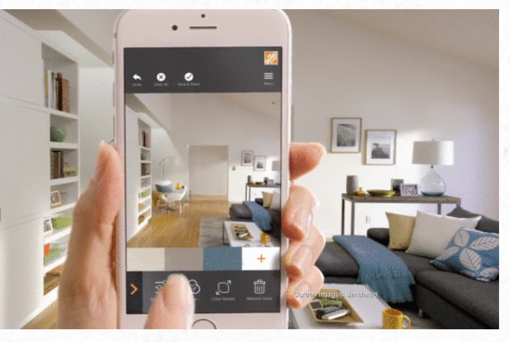Today’s customers want immersive experiences. Learn more from our guest author Ray Ko about the many ways retailers are improving CX with VR, AR, AI, and much more!
- Going Fully Immersive with VR
- Augmented Reality is Gaining Steam
- Where AR for Retail is Headed
- The Big Brands Get Creative
- Facebook and Instagram Are Making AR Ads More Accessible
- Regardless of the Technology, It’s Still About the Customer
From in-store virtual reality (VR) to online augmented reality (AR), immersive technologies are making headway in the world of retail.
Retailers have been dabbling in VR experiences for years. By the mid-20teens, Lowe’s—named the most innovative company in AR and VR in 2018 by Fast Company magazine—was using VR to help customers visualize home improvement projects and learn to operate power tools. In the automotive world, Lexus offered a VR test drive for one of its high performance models using the car’s actual steering column and an Oculus headset. Working with OLV, outdoor gear purveyor REI put a tent visualizer VR experience in its flagship retail store in Seattle that enabled people to see and walk around in tents the store didn’t have room to set up.
Going Fully Immersive with VR
VR technology has a strong presence in gaming as well as adaptive training and prototyping in healthcare, aerospace, industrial, automotive, and other industries, but those types of experiences remain few and far between in retail. Creating them doesn’t come cheap, and thanks to the pandemic, people will think hard about whether to put on communal headsets for a VR shopping experience like they did at mall kiosks in India for Amazon Prime Day in 2018. Shoppers aren’t going to be strapping those clunky headsets to their faces as they walk the aisles of their favorite stores anytime soon, either, no matter how amazing the VR experience.
Augmented Reality is Gaining Steam
AR, however, is another story. It does online shopping one better, overlaying digital information onto the physical world, like an aprés ski menu popping up on the slopes. The idea of being able to “try before you buy”—the ability to pick up products, turn them this way and that, see what they look like on or in a particular setting—has been enticing companies to develop all kinds of creative AR-based “productainment” online.

The pandemic has given “try on” AR ads a boost. When clothing stores made physical fitting rooms off-limits, some brands created these types of ads on their digital properties, complete with a selection of items from their inventory. Makeup counters removed their testers, but people are still trying lipstick, eyeshadow, concealer, and hair color shades online. Furniture stores have developed apps that let you see a sofa, chair or rug in the room you plan to put it in. Sherwin Williams lets you upload an image of a room using its ColorSnap® Visualizer and play around with paint color. Warby Parker, the direct-to-consumer retailer, developed an AR app that lets shoppers see what various frames look like on their faces.
Where AR for Retail is Headed
Today, ARtillery Intelligence reports that mobile AR usage has grown to 29 percent among U.S. adults. Research by GoldmanSachs shows that two-thirds of internet users would be interested in virtual reality. Further, 63% said such technologies would change the way they shop despite the fact that AR has disappeared off the Gartner Hype Cycle altogether due to the fact that the technology matured rapidly and is no longer considered emerging. When even young children know how to capture a Pokémon or use a kitten photo filter, you know the genie’s out of the bottle.
In those same studies, ARtillery Intelligence anticipates that AR advertising will surpass $8 billion by the end of 2024, driven largely by social media advertising. That advertising can be as simple as creating AR that points out items in a store that are on sale, as in the image from PYMNTS.com.
GoldmanSachs puts the market for AR and VR in retail at $1.6 billion by 2025. Facebook is even more bullish, citing a Boston Consulting Group study that estimates 120 million people in the U.S. will be engaging with AR on a monthly basis by the end of the year. They’ve gone so far as to say that AR and VR “are the future” and that the growth of stories on its mobile platforms is making AR part of everyday communication with filters and animations.
The Big Brands Get Creative
For retailers with big advertising budgets, AR-enhanced experiences can increase brand awareness and engagement. For instance, Home Depot’s app that lets customers see how a paint color would look on their walls has evolved to include other home improvement products such as faucets.

In 2014, Pepsi had a wildly creative and successful AR moment when it took over a bus stop in London and treated people to incredible VR scenes that looked like they were happening right before their eyes. Participants dodged meteors seemingly headed straight for them, gasped at alien spaceships zooming overhead, and even jumped at a tiger running toward them on the sidewalk. People were clearly delighted.
Anyone who’s used the StubHub app to buy a ticket to a sporting event or concert at an NFL, NHL, NBA or MLB venue has likely experienced VR that lets you see what the view looks like from the seat you’re considering. The first year it was introduced, app engagement more than doubled. And on a more recent note, Ulta has seen engagement with its GLAMlab app increase seven-fold since the pandemic began, according to Harvard Business Review—more than 50 million shades of foundation have been swatched digitally post-Covid.
Facebook and Instagram Are Making AR Ads More Accessible
AR ads are still a bit of a novelty, but they are making headway on social platforms, which will make them more accessible to companies of all sizes—even those without the tech savvy or financial wherewithal to build custom apps. With hundreds of millions of active users across Facebook and Instagram (which it owns), Facebook is a natural place for retailers to try ads enhanced with AR to provide a personalized customer experience. Big brands such as Michael Kors and L’Oreal were early adopters. Today, Facebook features 16 AR ad success stories from airlines and banking to cosmetics, clothing, and even the Lucky brand’s body wash.

Since Facebook really, really wants to sell ads, they’ve made it as easy as possible (emphasis on “as possible”—there are still several steps) by building a network of AR production partners retailers can tap into to produce the effects that work best with their products. Once the effect is approved, step-by-step instructions enable retailers to create AR ads in Ads Manager. If you want to tinker around with it after it’s published, that’s fine—if you’re already using an effect, the ad updates automatically with the new version. The ads, such as those shown here, appear in mobile Facebook News Feeds.
Instagram began tinkering with AR in 2019, launching “try on” ads with a handful of brands to let shoppers see what various products looked like on them before committing to a purchase. The aforementioned Warby Parker was one of them, as were Mac and Nars cosmetics, and Ray-Ban.
Regardless of the Technology, It’s Still About the Customer
VR, AR, artificial intelligence and the like all have their place in creating immersive experiences, but one thing remains at their collective heart — value. Technology for technology’s sake just won’t cut it. Immersive experiences should still be firmly grounded in research and data that shows how customers act and what motivates them to do so.
The novelty of an AR-enhanced ad or a VR experience may draw people in, but giving them something useful will keep them engaged and coming back for more. That’s why “try before you buy” functionality has driven so much of the experimentation to date. From StubHub’s 360-degree venue views to clothing retailers’ online dressing rooms, apps are giving people the information they need to be comfortable enough to buy what the company is selling. And we’re excited to see what’s next.





















